Ten years on from the global financial crisis how goes it for the UK and the pound?
General disgruntlement at the failure of improvement in UK living standards has had severe political implications.

It's been 10 years since the global financial crisis first reared its ugly head in the form of tightening liquidity conditions and reports of losses in US mortgage markets. Over that time, the UK's public sector net debt has increased almost four-fold, the Bank of England's base lending rate has fallen from 5.75% to 0.25%, and 10-year gilt yields from just above 5% to just above 1%.
Real GDP has increased by 13%, which looks respectable enough until you note a near 10% increase in employment. And while wages have increased by 22% over the last decade, consumer prices have increased by 26%.
The overall picture is of some growth in output, but more due to increased employment than to any productivity gains, which have been dismal.
The weakness in productivity is one factor holding down real wages, which have fallen slightly over the last decade.
It's not the only one of course and weak real wage growth is a universal story among developed economies. But UK households have been particularly afflicted by the impact of all this on the pound, and from there on inflation.
The value of the pound has fallen by 36% against the dollar, and by 25% against the euro. That's been a factor driving import and consumer price inflation, but unfortunately, it hasn't really done anything for the UK's balance of payments.
Exports and Imports have both grown by 55% in 10 years, which is respectable enough but the net result is that the trade deficit, £38.5bn in the year to June 2007, was £37.4bn in the year to June 2017. The current account balance performed worse – widening from £37.5bn in 2007 to £84.5bn in 2016.
General disgruntlement at the failure of improvement in living standards has had political implications, and is a factor in the vote to leave the EU. That, in turn, has created huge uncertainty over the UK's medium-term economic outlook, while the US economy continues to grow at a respectable pace, and the European economic outlook in general, is improving.
Beyond Brexit
The result is that although the UK's economic performance has been better since the referendum vote than many had feared, the country has still fallen sharply down global rankings.

If you measure your currency performance solely in terms of the dollar/sterling exchange rate, then 2017 hasn't been too bad - the pound is up by 5% against the dollar. However, that's mostly because the dollar has been the weakest of all the major currencies.
The only other majors that have underperformed the sterling are the New Zealand dollar, the Brazilian real, and the South African rand. At the other extreme, the euro, as well as Danish and Swedish kroner, have gained about 6% against sterling. It's no surprise that given the big falls against near-neighbours, the pound's trade-weighted value is slightly (2%) weaker than it was at the end of 2016.
Sterling vs exports
An uncertain economic outlook, and the contrast with the reduced political uncertainty in the euro area, is going to go on weighing on sterling. It's only defence is that the level, just 3% above the lows of the last decade (and 10% below the average), is pretty extreme. That probably means that it can't fall much further, even if the economic outlook argues against much of a bounce.
Hardly a thrilling prospect, and the failure of the fall in 2007-2009 to help boost the UK's export performance argues against getting hopes up too much regarding possible benefits for exporters from the currency's weakness.
Several years with low rates, a cheap currency, persistent current account and budget deficits and mediocre economic growth loom ahead for the UK.
If a near 30% fall in sterling's value in 2007-08 didn't help exports much, why would a 20% fall since mid-2015 have a huge impact; all the more so given the uncertainty about the UK's post-Brexit trading relationships?
Several years with low rates, a cheap currency, persistent current account and budget deficits and mediocre economic growth loom ahead for the UK. Meanwhile, global markets seem set to be driven by the continued weakness of both productivity and wage inflation in developed economies, which anchor interest rates and bond yields.
And in currencies, anchoring US interest rates means that any moves on the part of the European Central bank are likely to drive the euro higher. I still can't see how the euro area can hope to enjoy both an undervalued currency and a large current account surplus, unless monetary policy is devoted solely, or at least largely, to keeping the euro down.
The Big Mac index suggests EUR/USD fair value is 1.25, while the more sophisticated OECD measure of purchasing power parity is at 1.33. EUR/USD is likely to rise to a level between 1.25 and 133 in the next couple of years. In the process, the pound will lose ground to the Euro (GBP/EUR falling to 1.05 or so) while gaining a little against the dollar (towards 1.35).
Kit Juckes is the head of forex at Société Générale, having joined the French investment bank in 2010. A market veteran of over three decades, he has previously worked for ECU Group, RBS, Mitsui Bank and SG Warburg.
© Copyright IBTimes 2025. All rights reserved.




















